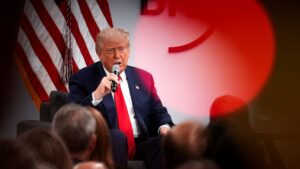The Corporate Landscape After Trump’s Inauguration: What We’ve Learned and What’s Next
On March 11, 2025, President Donald Trump addressed attendees at the Business Roundtable’s quarterly meeting in Washington, D.C. The context was significant; just three months earlier, American corporations had funneled millions into Trump’s inauguration festivities. With a record-setting $239 million raised—far exceeding previous years—questions lingered about whether these corporate giants would still enjoy the pro-business policies they had bankrolled.
The Impact of Donations: A Question of Return on Investment
From General Motors to BlackRock, numerous industry heavyweights contributed substantial sums to Trump’s inaugural committee. Donations were expected to ensure these organizations had influence as Trump’s economic agenda unfolded. Inaugural committees offer a peculiar exemption: there’s no limit on corporate donations, unlike election campaigns.
While the optimism during Trump’s reelection was palpable, reality soon set in as the president’s tariff policies triggered consumer caution across various sectors. Major corporations began to question if their substantial investments in political support translated into favorable policies.
Industries Feeling the Pinch
1. Tech Sector: A Double-Edged Sword
The tech industry, once again looking to mend ties with the Trump administration, contributed heavily to his inaugural funds, hoping to shift gears after a rocky first term. Leaders like Mark Zuckerberg of Meta and Jeff Bezos of Amazon contributed $1 million each, desperate to be maneuverable in a highly charged political environment.
However, as tariffs began to loom larger, concerns about raised import costs for essential tech components sparked fears of diminished profit margins. For instance, companies reliant on Nvidia chips faced the reality of disrupted supply chains and inflation in overhead expenses.
2. Food and Beverage: Adapting to New Normals
The food sector saw significant investments as well, particularly from companies like Pilgrim’s Pride, which made headlines with a $5 million donation. The industry has been under pressure to align with the administration’s regulatory decisions, and as public health measures grow stricter, scrutiny grows on businesses like McDonald’s that could be targets of new health-focused policies.
3. Retail: Anxiety in the Aisles
The retail sector faced unique challenges, especially due to Trump’s tariff policies, which cranked up consumer prices and dampened spending. Leading players like Target and Walmart contributed significantly but also voiced deep concerns regarding how these tariffs might impact their operating models. Reports indicated retail sales across sectors were already struggling, a warning sign for the upcoming season.
4. Healthcare and Pharmaceuticals: Political Gamesmanship
The healthcare industry, which traditionally plays an intricate game with political affiliations, contributed substantial sums hoping for more lenient policies. While many familiar names, like Pfizer and Johnson & Johnson, pushed for favor, they now face the uncertain implications of ongoing regulatory discussions under the new administration.
5. The Finance Sector: A Balancing Act
The financial giants bolstered Trump’s coffers by pouring in funds while simultaneously lobbying for deregulation to alleviate pressure from stringent post-pandemic regulations. However, as public backlash against corporate contributions mounts, these entities find themselves in a precarious position, caught between supporting political agendas and appeasing an increasingly skeptical public.
The Road Ahead: What Should Investors Watch For?
As the corporate landscape continues to unfold under Trump’s second term, several key insights can guide investors and business leaders navigating this tumultuous period:
-
Tariff Policy Changes: Keep a keen eye on any pivot in tariff policies—these can cause ripple effects across multiple industries. Anticipate how supply chains may adapt or face disruption due to ongoing trade tensions.
-
Corporate Contributions Scrutiny: As the spotlight on corporate donations intensifies, consider how public perceptions of these actions may influence long-term brand loyalty and market performance.
- Emerging Regulatory Landscapes: Watch for potential shifts in regulations, especially in the tech and healthcare sectors, which may affect everything from operational costs to market entry strategies.
At Extreme Investor Network, we provide actionable insights and in-depth analysis to help our readers make informed decisions in this ever-evolving business climate. Whether you’re a seasoned investor or just starting, understanding these dynamics could be crucial for your financial strategy.
For ongoing updates and analysis of the intersection between politics and business, stay tuned to Extreme Investor Network as we navigate through these complex terrains together.

